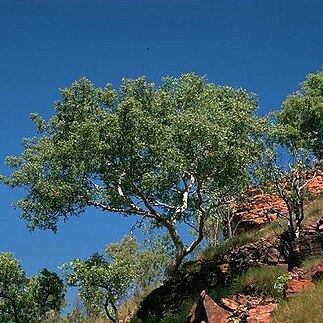Tree to 15 m tall, though often shorter. Forming a lignotuber.Bark either smooth throughout, white or cream to very pale grey or pink-brown, or with a basal stocking of grey-brown tessellated rough bark.Branchlets lack oil glands in the pith; setose to scabrid with bristle-glands. In this species the bristle-glands lack simple hairs.Juvenile growth (coppice or field seedlings to 50 cm): stems rounded in cross-section, setose with bristle-glands; juvenile leaves sessile, opposite, cordate to ovate, 2–6.5 cm long, 1–4.3 cm wide, amplexicaul, apex rounded and apiculate, margin entire, green to greyish green, setose with bristle-glands above and below. Crown consists of juvenile leaves, opposite, sessile or with petioles to 0.3 cm long; blade cordate to ovate or rarely ± elliptical, 1.5–6.8 cm long, 0.7–3.5 cm wide, base amplexicaul to rounded, margin entire, apex rounded, concolorous, dull, green to grey-green, usually setose to scabrid with bristle-glands, side-veins at more than 45° to midrib, reticulation dense to very dense, intramarginal vein present, oil glands not visible.Inflorescence axillary compound, condensed with only the basal internode obvious (to 0.6 cm long), peduncles rounded to angular, 0–0.3 cm long, buds 7 per umbel though may appear to be in umbels of more than this when peduncles are much reduced, pedicellate (pedicels 0.2–0.7cm). Mature buds obovoid to pyriform (0.3–0.5 cm long, 0.3–0.4 cm wide), surface smooth, scar present (outer operculum shed during bud development), operculum flattened and very shallow, stamens usually inflexed, rarely a few stamens irregularly flexed, all fertile, anthers oblong, dorsifixed, versatile, dehiscing by longitudinal slits, style long and straight, stigma ± tapering, locules 3, the placentae each with ovules arranged in ca 3 vertical rows or the rows indistinct. Flowers creamy white.Fruit pedicellate (pedicels 0.1–0.6 cm long), cupular to cylindrical or barrel-shaped, 0.5–0.8 cm wide, 0.4–0.7 cm wide, thin-walled, smooth, disc descending vertically, valves 3, enclosed.Seeds brown to reddish brown, flattened to saucer-shaped, dorsal surface smooth, hilum ventral. Cultivated seedlings (measured at ca node 10): not grown.
More
Tree to 9 m, often straggly. Bark mostly smooth, white or pale grey, but often scaly and tessellated at base. Juvenile leaves shortly petiolate, ovate, cordate, obtuse, 6–10 cm long, 4–5 cm wide, setulose mostly on veins beneath and stems. Leaves on mature trees subopposite or alternate, sessile or almost so, lanceolate to broadly lanceolate, truncate or cordate, thick, scabrous, becoming smooth; lamina 6–7 cm long, 2–3 cm wide, grey-green, rarely green; lateral veins at 60°–80°; intramarginal vein up to 2 mm from margin. Conflorescence an axillary, condensed panicle; umbels 3-flowered, sessile or almost so; pedicels 3–7 mm long. Buds clavate; operculum c. 1 mm long, 3 mm wide; hypanthium cupular, 3–4 mm long, c. 3 mm wide. Fruits truncate-ovoid, 5–10 mm long, 4–9 mm wide. Seeds with a rudimentary margin.


